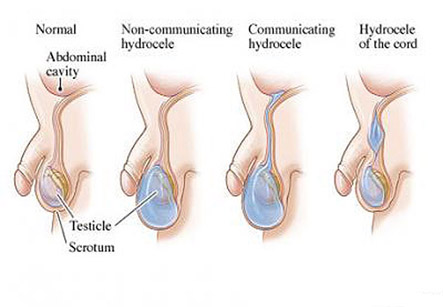Pediatric Hernia
Introduction
Inguinal hernia is the most common surgical problem during childhood. It results from a small sac which comes through the inguinal ring. This ring is normally open during fetal life and closes around the time of birth. It does not close in some infants for unknown reasons. This sac then makes a pathway for abdominal organs to come out through the inguinal ring into the groin. In boys, the organ protruding is usually a loop of bowel and, in girls; it may be bowel or an ovary. The hernia first appears as a bulge in the groin and usually pops out when the child cries or strains. If only fluid comes through the inguinal ring into the sac, the problem is called as a hydrocele.
Need for surgery:
Inguinal hernias never go away without surgical treatment. If untreated, a loop of bowel or other organ may become trapped or strangulated in the sac. Once trapped, the blood supply of the organ may be affected. Without adequate blood supply, the organ trapped in the hernia can become damaged or even die. If the child develops an incarcerated hernia, he or she may present with symptoms such as a hard, red, painful lump, vomiting, reduced desire to eat and constipation. This is an emergency and requires immediate surgery.
Iranian specialists have made remarkable achievements in infants' surgeries and Iran is among few countries that have gained access to the latest surgical technologies

Surgery for pediatric hernia:
The surgery takes about one hour. The pediatric surgeon closes the opening to the hernia sac laparoscopically, using small instruments inserted through 2 or 3 tiny incisions.
After the operation the child will return back to the recovery area, and the parents can be with the child while he or she is waking up.
In some children, the hernia sac needs to be closed through a very small (about one inch) incision in the groin. This is called an “open” operation. The pediatric surgeon will discuss about which approach is best for the child. Children less than one year of age can have an open sac on the other side which may become a hernia later. The surgeon may use a tiny telescope to look for a hernia on the opposite side and close it if there is one. This will be discussed by the surgeon before the operation. Usually, there is no need to remove the stitches from the skin as the stitches are placed under the skin and will dissolve on their own. The child’s skin will be covered with small bandages.
Hospital stay:
After the operation the child will return back to the recovery area, and the parents can be with the child while he or she is waking up. Some children are upset and confused as the anesthesia starts wearing off. Most children go home as soon as they are awake and able to drink liquids after the operation. In case of any complication, however, the child needs to stay in the hospital overnight.
Pain Management
At the end of the operation, the surgeon will put a long-acting, numbing medication into the incision. Most children are given Acetaminophen or Ibuprophen by mouth every four to six hours for the first 24 hours after surgery. If the child is still uncomfortable, then the doctor should be visited.
Care for Dressings
Gauze and clear plastic dressings are removed two days after surgery. Under the gauze, there may be a small amount of blood, which is normal. The skin surround the incision may be red and bruised, and the incision will be slightly swollen. In some children, the stitches may come through the incision about 4 weeks postoperatively. There may be associated pain and pus formation. This is normal and is best treated by gently cleansing the area with soap and water. When the suture falls out or completely dissolves, the wound will heal.
Swelling after Surgery:
There will be some swelling at the incision. In boys, swelling of the scrotum is normal after the hernia surgery, and may take several weeks to go away completely. In girls, there may be some swelling in the skin folds below the incision. For both boys and girls, you will be able to feel a firm ridge under the incision that lasts several months. This is called a “healing ridge”, and is where the tissues are sewn back together.
Bathing Restrictions:
The child may bathe or shower two days after surgery. Before then, a sponge bath may be recommended.
Activity Restrictions
There are no specific restrictions on activity. Children will limit their own activity until they feel better, and most are back to normal activity in a day or two. Some children may require several days to feel better.
Follow-up:
One or two weeks after the operation, a follow-up appointment with the child’s pediatrician may be fixed for evaluation of child. A visit to the office within one month after the surgery is recommended.